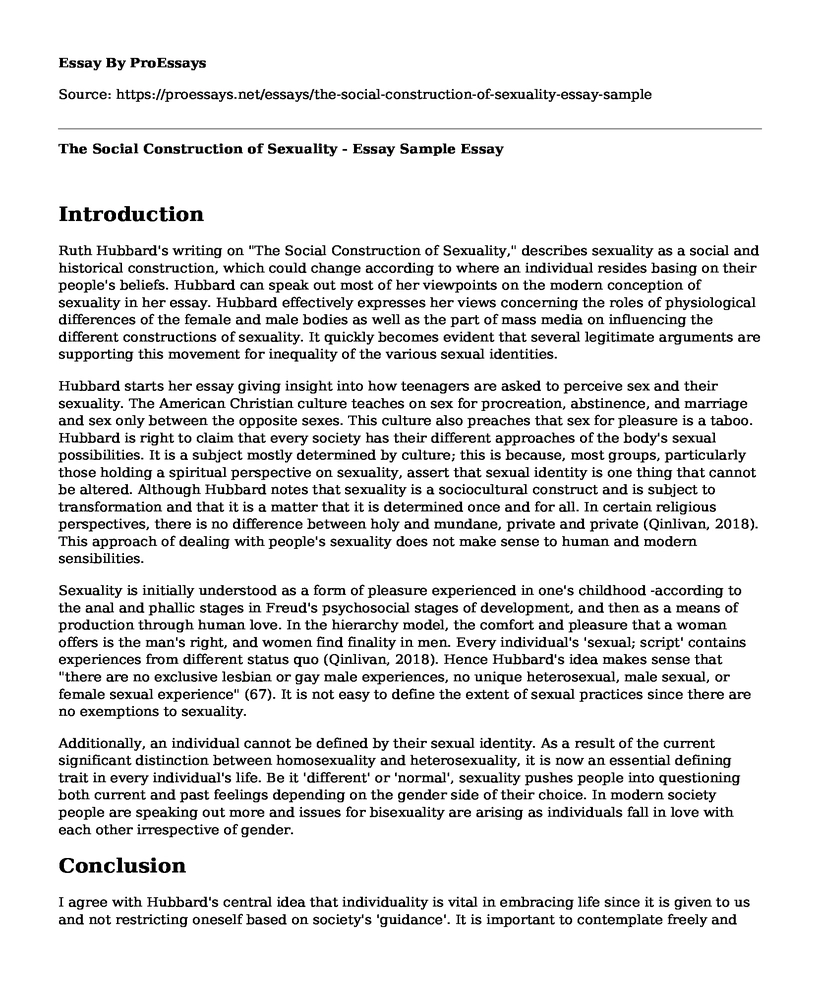Introduction
Ruth Hubbard's writing on "The Social Construction of Sexuality," describes sexuality as a social and historical construction, which could change according to where an individual resides basing on their people's beliefs. Hubbard can speak out most of her viewpoints on the modern conception of sexuality in her essay. Hubbard effectively expresses her views concerning the roles of physiological differences of the female and male bodies as well as the part of mass media on influencing the different constructions of sexuality. It quickly becomes evident that several legitimate arguments are supporting this movement for inequality of the various sexual identities.
Hubbard starts her essay giving insight into how teenagers are asked to perceive sex and their sexuality. The American Christian culture teaches on sex for procreation, abstinence, and marriage and sex only between the opposite sexes. This culture also preaches that sex for pleasure is a taboo. Hubbard is right to claim that every society has their different approaches of the body's sexual possibilities. It is a subject mostly determined by culture; this is because, most groups, particularly those holding a spiritual perspective on sexuality, assert that sexual identity is one thing that cannot be altered. Although Hubbard notes that sexuality is a sociocultural construct and is subject to transformation and that it is a matter that it is determined once and for all. In certain religious perspectives, there is no difference between holy and mundane, private and private (Qinlivan, 2018). This approach of dealing with people's sexuality does not make sense to human and modern sensibilities.
Sexuality is initially understood as a form of pleasure experienced in one's childhood -according to the anal and phallic stages in Freud's psychosocial stages of development, and then as a means of production through human love. In the hierarchy model, the comfort and pleasure that a woman offers is the man's right, and women find finality in men. Every individual's 'sexual; script' contains experiences from different status quo (Qinlivan, 2018). Hence Hubbard's idea makes sense that "there are no exclusive lesbian or gay male experiences, no unique heterosexual, male sexual, or female sexual experience" (67). It is not easy to define the extent of sexual practices since there are no exemptions to sexuality.
Additionally, an individual cannot be defined by their sexual identity. As a result of the current significant distinction between homosexuality and heterosexuality, it is now an essential defining trait in every individual's life. Be it 'different' or 'normal', sexuality pushes people into questioning both current and past feelings depending on the gender side of their choice. In modern society people are speaking out more and issues for bisexuality are arising as individuals fall in love with each other irrespective of gender.
Conclusion
I agree with Hubbard's central idea that individuality is vital in embracing life since it is given to us and not restricting oneself based on society's 'guidance'. It is important to contemplate freely and not feel pressured to behave in specific ways, just because that is the norm and what society expects of the human race. This nation does not have any 'normalcy' in terms of sexuality - with the rising trends in gay relationships and marriages. Most individuals come from diverse cultural backgrounds and ought to be accepted for who they are, instead of being stereotyped for their sexual identity. Self-comfort is the most crucial lesson from Hubbard's essay. If young ones are permitted to explore their sexual constructs with those of the opposite sex, they could acquire a sense of comfort and be more ready in experiencing their sexuality in adolescence and adulthood.
Reference
Hubbard, R. (2007). The Social Construction of Sexuality. Race, Class, And Gender in the United States, 65-68.
Quinlivan, K. (2018). "An Epidemic of Love": Drawing on Students' Lived Experiences of Challenging Hetero and Gender Normalcy to Engage with Sexual and Gender Diversity in the Classroom. In Exploring Contemporary Issues in Sexuality Education with Young People (pp. 67-86). Palgrave Macmillan, London. doi:10.1057/978-1-137-50105-9_1
Cite this page
The Social Construction of Sexuality - Essay Sample. (2022, Dec 19). Retrieved from https://proessays.net/essays/the-social-construction-of-sexuality-essay-sample
If you are the original author of this essay and no longer wish to have it published on the ProEssays website, please click below to request its removal:
- Communications and Emotional Intelligence Essay
- Exploring the Barriers: Studies in Race, Class, and Gender Paper Example
- Essay on Bullying Within Friendships: An Analysis of Victimization Among Peers
- Essay Example on Urban Communities Need Innovative and Adaptable Workforce to Survive
- Interpretations of Family and Gender Roles: A Comparative Analysis - Essay Sample
- Essay Example on Unlock Collective Power: Civil Engagement and Interests Groups
- Paper on Unveiling Art: Exploring the Significance of Appearance and Content in Artworks







